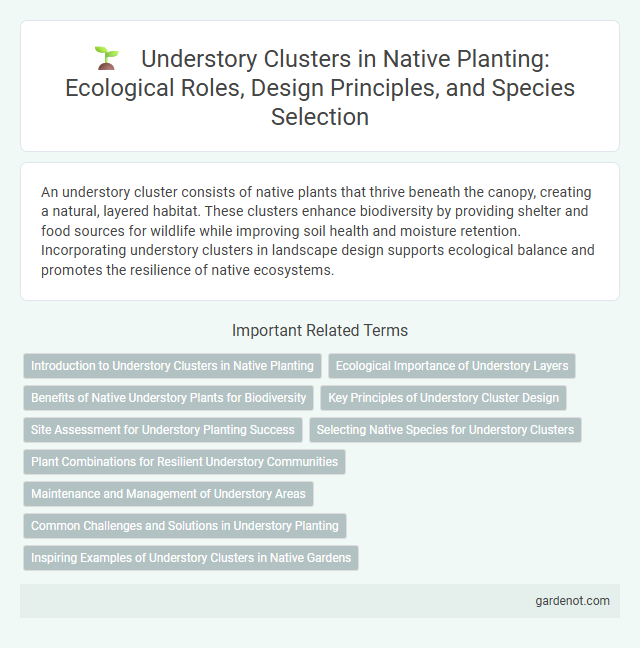An understory cluster consists of native plants that thrive beneath the canopy, creating a natural, layered habitat. These clusters enhance biodiversity by providing shelter and food sources for wildlife while improving soil health and moisture retention. Incorporating understory clusters in landscape design supports ecological balance and promotes the resilience of native ecosystems.
Introduction to Understory Clusters in Native Planting
Understory clusters in native planting consist of shade-tolerant shrubs, ferns, and wildflowers that thrive beneath the forest canopy, creating a layered habitat structure. These clusters enhance biodiversity by providing shelter and food for pollinators, birds, and small mammals while improving soil health through natural leaf litter decomposition. Incorporating understory clusters supports ecological balance, promotes native species resilience, and contributes to sustainable landscape design.
Ecological Importance of Understory Layers
Understory layers in native planting play a crucial role in enhancing biodiversity by providing unique habitats for insects, birds, and small mammals. This vegetation strata improves soil health through nutrient cycling and moisture retention, supporting overall ecosystem resilience. Understory clusters mitigate erosion and create microclimates that protect tree roots and foster seedling growth.
Benefits of Native Understory Plants for Biodiversity
Native understory plants play a crucial role in enhancing biodiversity by providing habitat and food sources for a wide range of insects, birds, and small mammals. These plants improve soil health through nutrient cycling and support mycorrhizal networks that foster tree growth. Their presence stabilizes forest ecosystems, increases resilience against invasive species, and maintains ecological balance.
Key Principles of Understory Cluster Design
Understory cluster design emphasizes native species that thrive beneath the forest canopy, promoting biodiversity and ecosystem health. Key principles include selecting shade-tolerant plants, grouping species based on similar water and soil needs, and arranging clusters to enhance natural successional stages and habitat connectivity. This approach supports wildlife by providing shelter and food while maintaining soil stability and moisture retention.
Site Assessment for Understory Planting Success
Conducting a thorough site assessment is crucial for understory planting success, involving evaluation of soil type, moisture levels, light availability, and existing vegetation. Understanding microclimate conditions and drainage patterns helps select native understory species suited to the specific environmental factors. Accurate site assessment ensures optimal growth, promotes biodiversity, and supports ecosystem resilience in native planting projects.
Selecting Native Species for Understory Clusters
Selecting native species for understory clusters enhances biodiversity by providing habitat and food sources for local wildlife. Focus on shade-tolerant shrubs, ferns, and wildflowers such as Spicebush (Lindera benzoin), Christmas fern (Polystichum acrostichoides), and Virginia bluebells (Mertensia virginica) to create a layered, resilient ecosystem. Native understory clusters improve soil health and moisture retention, supporting the overall stability of forested landscapes.
Plant Combinations for Resilient Understory Communities
Understory clusters thrive through strategic plant combinations that enhance resilience by improving soil health, moisture retention, and biodiversity. Integrating native species such as ferns, shade-tolerant shrubs, and wildflowers creates complementary root structures and varying nutrient demands, reducing competition and promoting ecosystem stability. These diverse assemblages support pollinators and beneficial microorganisms, strengthening the entire understory community against environmental stresses.
Maintenance and Management of Understory Areas
Effective maintenance of understory clusters involves regular monitoring for invasive species and selective pruning to promote healthy growth of native plants. Proper management includes mulching to retain soil moisture and periodic assessment of plant density to avoid overcrowding, which can inhibit biodiversity. Encouraging natural regeneration through minimal disturbance supports the resilience and ecological function of native understory habitats.
Common Challenges and Solutions in Understory Planting
Understory planting often faces challenges like limited light availability, soil compaction, and competition from invasive species, which hinder native plant growth. Selecting shade-tolerant species such as ferns and wild ginger, improving soil quality with organic mulch, and implementing consistent invasive species management effectively address these issues. Proper site assessment and continuous monitoring ensure the successful establishment and sustainability of understory clusters in native plant habitats.
Inspiring Examples of Understory Clusters in Native Gardens
Understory clusters in native gardens exemplify biodiversity by combining shade-tolerant species like ferns, wild ginger (Asarum canadense), and trilliums, which thrive beneath taller canopy trees. These plant groupings create microhabitats that support pollinators and improve soil health through layered root systems. Notable examples include the Pacific Northwest's use of salal (Gaultheria shallon) and sword fern (Polystichum munitum) clusters that enhance forest resilience and aesthetic complexity.
Understory cluster Infographic

 gardenot.com
gardenot.com